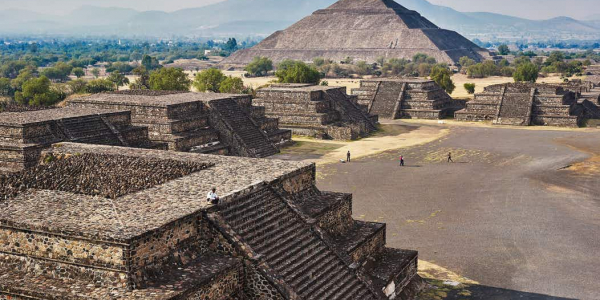Old men dressed in military uniforms playing hurdy-gurdeys made in 19th century Berlin; knifegrinders and scribes: emigrants from a world of improvised solutions to everyday problems. The knifegrinder had set up shop on the street just outside a beautiful eighteenth-century building filled with people who had come for a book launch, gathering in the beautiful colonial courtyard at dusk. He pedaled a bicycle wheel that drove an axle attached to a flintstone, on which he sharpened the blades his clients brought him. The sparks and grate of metal on stone mixed with the cacophony of street vendors peddling their wares blended with the clamor of promenaders walking the pedestrian mall in the waning afternoon.
Our time in Mexico City seemed to expand to take up a much larger space than our five crowded days there, reaching from the vast ritual spaces of Téotihuacan an hour by bus from the Distrito Federal, to the halls of the Syndicate of Electricians, site of one of the most cinematically impressive murals of the post-revolutionary decades in Mexico by David Alfaro Siqueiros. It was a social journey as well, into a world where most people make do with very little while thriving on a communal street culture unmatched by any city north of the border. It was, as one student wrote, “a most enriching week --aesthetically, intellectually, gustatorially, sonically, and socially!” From conversations with union activists to witnessing a rainstorm from the balconies above the Zócalo--the central public space of Mexico City-- to studying onsite some of the most massive and ambitious public murals in the world—the ‘Sistine chapels’ of the Mexican Revolution—we entered a history and culture different in fundamental ways from where we had come. There were many lessons for us all, beyond the joys of sun-warmed pedestrian malls, adventurously new cuisine (ant eggs and corn fungus, as well as smoky rich chocolate-infused molé) and a form of intensely public urban space characteristic of most of the world beyond Europe and the US. We witnessed a culture in which the past is only one millimeter below the surface, pressing its claims from the Aztec excavations below the Zócalo, to the subsiding foundations of modern buildings, sinking slowly into the primordial ooze of the lakebed on which the city was built some five centuries ago; from the frightening Aztec goddess Coatlicue, holding court in the Museum of Anthropology-- decorated with human skulls and snakes—to the great mural cycles of Diego Rivera, bringing vividly to life the imagined world of the Valley of Mexico before the Fall (the Conquest).
For students of Art History and visual culture, perhaps the greatest lesson was of an art form that addressed the public directly, with monumental images and narratives of nation-building: long histories arcing across the divide between pre-and post-Conquest Mexico, and forging continuities between Mexico’s own revolutionary legacy and struggles for justice, and the international events leading up to World War II and beyond. A public art that remains today a part of the everyday environment of ordinary Mexicans.
Angela Miller and her students in “Transnational America” gratefully acknowledge the support of the Art History and Archaeology Department, whose travel fund supported their week-long trip to Mexico City over Spring Break.


